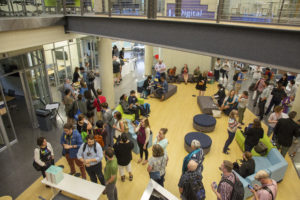Humans and technology are better together, according to National Public Radio education journalist Anya Kamenetz, just like the powerful mythological centaur that’s half-man and half-horse.
The message she delivered to educators from around the world is that we need a little of both, and that one should not exist without the other. Kamenetz created the keynote address, “Human Wisdom vs. Artificial Intelligence, or Monkeys vs. Robots,” especially for the University of Mary Washington’s Digital Pedagogy Lab (DPL). The five-day event, an international community of like-minded teachers, opened yesterday.
She asked participants to join her in tackling the anxiety that surrounds technology in education – a topic she called crucial in today’s fast-moving world. “I’m really here asking for your help in thinking through some of these questions,” she told the crowd in the Hurley Convergence Center’s Digital Auditorium.
She said educators could take a page from the field of artificial intelligence – a field focused on constant improvement, creativity and independent paths to meeting goals. Her advice: Borrow these guiding principles, but don’t forget about human qualities like empathy, humor, decision making and storytelling.
“The artificial-intelligence radiologist might spot the cloud on a scan,” Kamenetz said. “But you really need a person to sit down and tell you what your prognosis is, help you think through the treatment options, hand you a tissue.”

She cited success stories from the projects she’s covered, including a nonprofit that combats stress in low-income communities by emphasizing the power and resilience of the mind, and a college program that uses collaborative study and supportive learning to solve social problems.
Winner of multiple awards for her education reporting, including the 2017 Edward R. Murrow Award for “Excellence in Innovation,” Kamenetz has written four books. She joined NPR in 2014, and has also contributed to The New York Times, The Washington Post, New York Magazine, Slate, and O, the Oprah Magazine, and she has appeared in documentaries on PBS and CNN.
“What I appreciate most about Anya is her centering of the human in all that she does,” DPL Director Sean Michael Morris said in his introduction, following UMW President Troy Paino’s welcoming remarks. “No matter what she’s covering … Anya’s clear concern is with people.”
Pointing to an Oxford study, Kamenetz listed four human tasks on which robots consistently perform poorly: making sandwiches, giving hugs, telling stories and solving mysteries. As time goes on, though, and more and more information is fed to artificial intelligence, computers get smarter and smarter, she said.
“We’re ultimately hoping that they are going to far surpass anything we humans can imagine, and they’re going to solve the world’s problems,” she said. “That level of faith and hope and trust in our computers is something that would be great for every teacher to have in a student, and it would be great for every student to feel that a teacher had in them.”
But hugs and sandwiches will always need a human touch.


